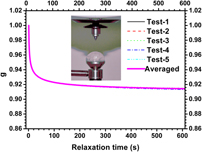Crossref Citations
This article has been cited by the following publications. This list is generated based on data provided by
Crossref.
Cao, Yan-Ping
Li, Guo-Yang
Zhang, Man-Gong
and
Feng, Xi-Qiao
2014.
Determination of the Reduced Creep Function of Viscoelastic Compliant Materials Using Pipette Aspiration Method.
Journal of Applied Mechanics,
Vol. 81,
Issue. 7,
Zhang, Man-Gong
Chen, Jinju
Feng, Xi-Qiao
and
Cao, Yanping
2014.
On the Applicability of Sneddon's Solution for Interpreting the Indentation of Nonlinear Elastic Biopolymers.
Journal of Applied Mechanics,
Vol. 81,
Issue. 9,
Zhang, Man-Gong
Cao, Yan-Ping
Li, Guo-Yang
and
Feng, Xi-Qiao
2014.
Pipette aspiration of hyperelastic compliant materials: Theoretical analysis, simulations and experiments.
Journal of the Mechanics and Physics of Solids,
Vol. 68,
Issue. ,
p.
179.
Boccaccio, Antonio
Lamberti, Luciano
Papi, Massimiliano
De Spirito, Marco
and
Pappalettere, Carmine
2015.
Effect of AFM probe geometry on visco-hyperelastic characterization of soft materials.
Nanotechnology,
Vol. 26,
Issue. 32,
p.
325701.
Liu, Dong
Li, Guo-Yang
Su, Chen
Zheng, Yang
Jiang, Yu-Xuan
Qian, Lin-Xue
and
Cao, Yanping
2018.
Effect of ligation on the viscoelastic properties of liver tissues.
Journal of Biomechanics,
Vol. 76,
Issue. ,
p.
235.
Li, Guo-Yang
Zheng, Yang
Jiang, Yu-Xuan
Zhang, Zhaoyi
and
Cao, Yanping
2019.
Guided wave elastography of layered soft tissues.
Acta Biomaterialia,
Vol. 84,
Issue. ,
p.
293.
Peng, Bo
Feng, Xi-Qiao
and
Li, Qunyang
2020.
Decohesion of a rigid flat punch from an elastic layer of finite thickness.
Journal of the Mechanics and Physics of Solids,
Vol. 139,
Issue. ,
p.
103937.
Peng, Bo
Li, Qunyang
Feng, Xi-Qiao
and
Gao, Huajian
2021.
Effect of shear stress on adhesive contact with a generalized Maugis-Dugdale cohesive zone model.
Journal of the Mechanics and Physics of Solids,
Vol. 148,
Issue. ,
p.
104275.
Zhang, Man-Gong
Xu, Wenshuai
Wu, Tao
Zhang, Xiang-Dong
Zhang, Hao
Li, Zhao
Zhang, Chao
Jiang, Heng
and
Chen, Meng
2021.
Investigation on Mullins effect of rubber materials by spherical indentation method>.
Forces in Mechanics,
Vol. 4,
Issue. ,
p.
100037.
Su, Lijun
Qi, Bing
Yin, Jun
Qin, Xuan
Genin, Guy M.
Liu, Shaobao
and
Lu, Tian Jian
2024.
Compressive response of white matter in the brain at low strain rates.
International Journal of Mechanical Sciences,
Vol. 277,
Issue. ,
p.
109415.
Wu, Fa
Wang, Qingao
Li, Chun
Li, Qunyang
and
Gao, Huajian
2024.
Ellipticity enhances adhesion strength for contacts under shear loads.
Journal of the Mechanics and Physics of Solids,
Vol. 187,
Issue. ,
p.
105596.
Hunnicutt, W.A.
Struble, L.J.
and
Mondal, P.
2024.
Nanoindentation Methods for Viscoelastic Characterization of Stiff Porous Materials.
Experimental Mechanics,
Vol. 64,
Issue. 8,
p.
1357.



